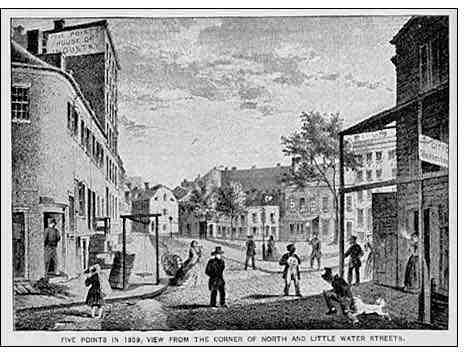
Page 6
From the New
York Daily Tribune, Wednesday, June
19, 1850.
THE DENS OF DEATH…No. III
DEPRIVATION OF LIGHT – DISEASE
IN THE DENS –
RATIO OF MORTALITY AMONG CHILDREN – SANITARY REGISTRATION.
RATIO OF MORTALITY AMONG CHILDREN – SANITARY REGISTRATION.
Among the places the most crowded in
proportion to their actual size, the worst ventilated, and
whose mortality is the greatest at all times, are those
subterranean abodes
which constitute the subject of our
remarks, and which we have denominated – for want of a
more appropriate term – Dens, Dens of Death; the term
“cellar” not conveying a proper idea of the place
when used as a residence. [“CELLAR – A room under a
house, used as a repository for provisions,” &c.
&c. &c. – Webster].
 | ||
These dens, or artificial caves of the
earth, like the natural caves in former times in Africa, often
send forth bands of murderers, who live by thieving alone; and
the modern Troglodytes, like their prototypes, after a
successful expedition, return to their dark recesses to divide
their spoil and plan a new scheme of depredation.
Darkness, therefore, would appear to have been from the
earliest times one of exciting causes of crime, and our modern
policemen see it is so now. We heard a worthy Alderman
once say that plenty of gaslight in the streets would go far to
exterminate wickedness of all kinds. Whether darkness be
a cause of crime or not, it is certain that murderers, thieves,
etc. “love darkness better than light,” and that
there is more propriety of deportment found in a good, honest
abode above-ground, fully open to the light of day, than in
dark under-ground residences and caverns, which in a state of
nature are inhabited only by beasts of prey. But we have
not undertaken to consider the relative state of morals of
Subterraneans and of the “Upper Ten,” such as live
on the surface of the earth; we shall, therefore, pass to the
subject of the consideration of the physical effects of living
in these damp and stifling abodes of darkness.
These places are the habitations of
the most destitute, and contain in themselves all the usual
active agents, independently of the presence of numbers of
people, for the spread of malignant diseases. They are
always more or less damp, often wet, and never undergo any
change of air, except to a very limited extent, and always
accidental.
We have mentioned darkness as one of
the characteristics of a den of death; we mention it because it
possesses the property of modifying and controlling the
development of organic life, and in such a way as always to
render the body exposed to its influence less vigorous.
The external visible effect of the
absence of light are obvious and known to most persons.
The blanching of vegetable sprouts that are deprived of
light, and of the portions of the bodies of animals, and of
their hairy covering that are habitually kept in comparative
darkness, of the under parts of the bodies of fishes,
especially of the flounder tribe – all illustrate the
differences that exist in the vital action of the parts exposed
to light or deprived of its active influence.
* * *
* * * *
*
These places are always damp, and are
thus a continued source of various inflammatory diseases;
indeed the occupants of them are always sick in a never-ending
rotation, and demands for medical services are more frequent by
the inhabitants of dens, than by such as live on the surface,
in proportion to their number. Sickness among the poor is
always
great, and in the damp and badly
ventilated abodes we are considering, is more protracted,
beside being more fatal, than above ground, so that if life is
prolonged it is too frequently an existence of helpless misery.
More than two-thirds suffer from lingering disease,
existing mostly among such as are constantly exposed to the
causes that are always in action in those places – as
women and children. The number of females prescribed for
at the dispensaries is always greater than that of the males,
from their being exposed to the confined air of their rooms
nearly the whole of the day and night, while the males pass the
day at their usual outdoor work, and are under the influence
only at night. From an actual record of 5,548
persons attended at their own houses from one of the
Dispensaries of the City, it appears that there was fifteen per
cent more sickness in the underground residences than in other
apartments.
 | ||
Whenever typhus fever has prevailed,
it was always worse in cellars or in the first floors that were
immediately next to the ground, and when it appeared in the
upper rooms it was found that they were always excessively
crowded, and as badly ventilated as the basement rooms.
In the year 1820 typhus fever prevailed in Bancker st.
There were 562 blacks living in the infected district, of
these 119 lived in cellars, of whom 54 or 45.50 per cent were
sick; the remaining 443 lived in the upper rooms; of whom 101
or 22.77 per cent, were sick. Of 120 white persons living
above ground in this district, not one was sick. (Dr.
John H. Griscom, on the Sanitary Committee of the pauper
population.)
We are not aware of any account
existing of the location of this disease when it appeared in
New York in 1847.
It is not generally known that the
rate of mortality on the City of New York has been steadily on
the increase since the year 1835. The following statement
will show the rate: the population of 1848 is an estimate
founded upon the per centage of increase, the other facts are
derived from the Annual Reports of the City Inspector:
1835 the population was 270,089
Deaths……6,608 – 1 to 40.87
1840 “
“
“ 312,710 “
……7,868 – 1 to 39.74
1845 “
“
“ 371,223 “
……9,886 – 1 to 37.55
1848 “
“
“ 412,155 “
…..14,199 – 1 to 29.03
1849 “
“
“ 450,000 “
…..22,006
Deduct extraordinary (City Inspector)
6,579 …15,427 – 1 to 29.81
What is the cause
of this increase can only be discovered with accuracy by a
proper scientific sanitary survey. We have no doubt,
however, that it arises mainly from immoderate crowding of the
poorer classes. It is not unusual to a high rate of
mortality to immigration; but what is this but crowding , and
that, too, of such as are esteemed healthy? For the sick by law
are detained many miles from the city before they are allowed
to enter. If there exists any doubt as to the cause, so
much greater the reason is there for an efficient survey, not
only of the City but of the State. A survey under the
provisions of the State Registration Law would exhibit the
ratio of mortality in the different sections of the State; and
the causes of these differences must be ascertained by a proper
investigation made by a suitable commission appointed for the
purpose.
This is certainly a condition that
demands prompt, decided and energetic action to ascertain the
cause and apply the remedies. Imperfect measures, without
decided foundation or without any clear object, are worse than
unusable.
Although vast improvements have been
made in the dwellings, streets and ventilation of the cities,
and although we have not among us any of those wretched dens,
crooked, damp, and dark passages, such as still exist in some
of the cities of the Eastern world, nor even anything that
bears a resemblance to the close, dark and dismal abodes of the
poorer classes in Edinburgh, Glasgow, etc. yet there are among
us too many of the hot-beds of disease, where the seeds of
pestilence rapidly take root, and where their noxious products
impart their deadly poison to the surrounding air. Crowds
must always exist in large cities, where space is always
valuable. But this should be the best reason why the
actual condition of the mode of living among the most destitute
should be known, for without the knowledge the appropriate
remedies can never be applied.
Recent facts in Prisons and on ship-
board show what can be done to obviate the evil effects of a
necessary crowding, and although the mortality in them may
still be reduced, yet if it remains as it now is, it will, by
comparison with former days, be a perfect triumph for science,
in preventing the extension of pestilence.
The average number of people living in
one room among the very poor in our city is about six, the
extreme number is twenty. The average number occupying
one house among this class of people is about sixty.
These are permanent dwellers – The occasional
lodgers swell the number to an incredible amount; the place
known as the Old Brewery at the “Five
Points” has often
contained as many as three hundred. In one room there
have been known to have been from two to four families; most of
these will take lodgers. Such an arrangement prevails in
all parts of the City where the extremely poor reside.
Sleeping together in such numbers in
one room always produces a feeling of exhaustion and physical
misery, and where it can be done resort is had to low priced
alcoholic drinks for its temporary relief. Hundreds of
the poorer class of lodging-houses depend in part for their
support on the inebriating drinks that are sold to their
inmates; indeed most of these houses have no other customers.
Although a display of shop window with bottles is made,
it is not to entice the accidental wayfarer, but is in reality
a species of sign indicating the class of lodging-house, and is
as well understood by those for whom it is intended as a
lettered sign for ordinary business. The pauper’s
whiskey and never is deficient in accommodations, whatever the
demand, and is always filled, whatever be the size of the
house. The effects of those circumstances combined, in
the event of pestilence, may be conceived.
Children suffer the most from a
crowded mode of living; the children of the poor die in
frightful numbers, the greatest number is from this cause
alone. In the year 1848 the whole number of deaths from
disease was 14,199, of which 6,847 were children under five
years, and in 1849, deaths 22,006, children under five years,
9,057.
In the Summer such a state of living
must be almost insupportable, and in the evening in some of the
poorest parts of the city, the doors, and windows, and steps
will literally swarm with people, instinctively endeavoring to
obtain a little fresh ait. We were never more struck with
this instinctive appetite than by an occurrence which happened
a few years since. As we was returning home late at
night, we saw a man stretched out at full length on a cart, and
just as we had discovered what it was, another issued from a
poor looking house, remarking to the first mentioned that
“he could not stand it any longer in the house” and
had come to follow his example; and accordingly placed himself
beside his friend on the cart apparently for the purpose of
taking his night’s rest.
Will anyone say that it is safe to the
general health, humane to the poor, creditable to our
civilization, or in any manner right and proper that these Dens
should continue as they are – human packing houses and
fountains of Disease and Vice?
_____________________________
©2003 The Composing Stack Inc.
©2003 Gregory J. Christiano
|
|
||
|
|
||
|
|
|
|